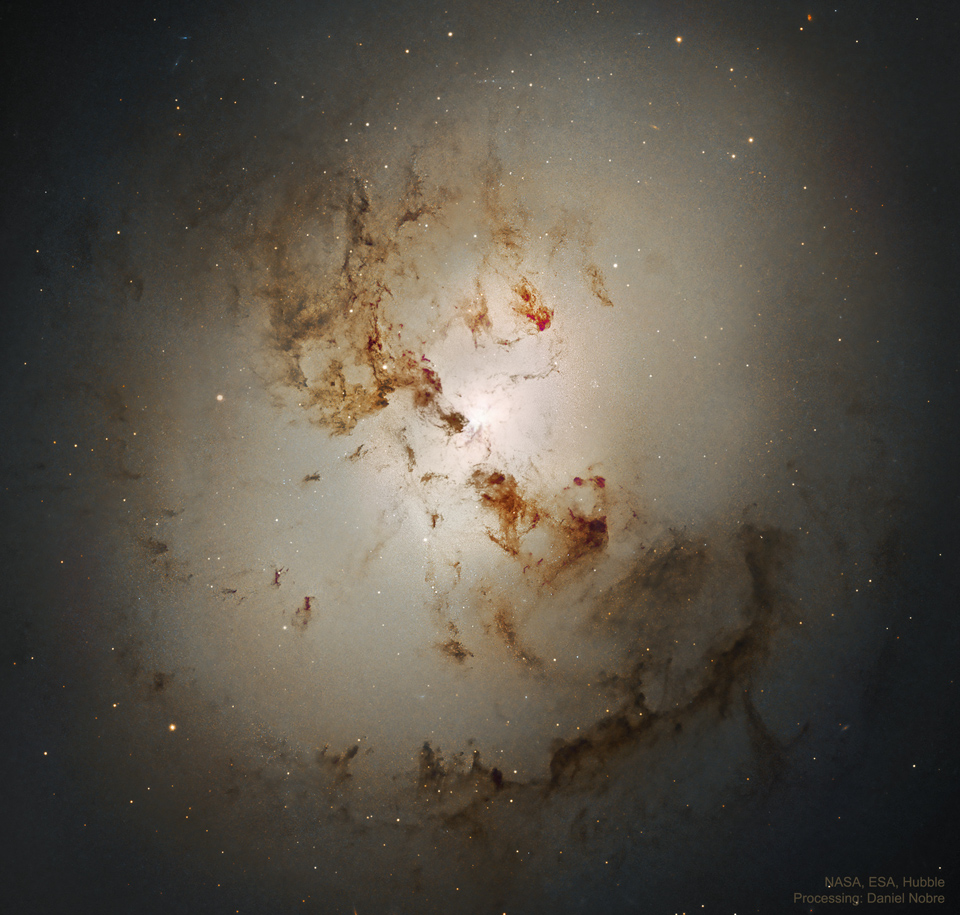Spiral galaxy Messier 66 lies a mere 35 million light-years away. The gorgeous island universe is about 100 thousand light-years across, similar in size to the Milky Way. This reprocessedHubble Space Telescope close-up view spans a region about 30,000 light-years wide around the galactic core. It shows the galaxy’s disk dramatically inclined to our line-of-sight. Surrounding its bright core, the likely home of a supermassive black hole, obscuring dust lanes and young, blue star clusters sweep along spiral arms dotted with the tell-tale glow of pinksh star forming regions. Messier 66, also known as NGC 3627, is the brightest of the three galaxies in the gravitationaly interacting Leo Triplet.

see full post...
Osbourne Ruddock (28 January 1941 – 6 February 1989), better known as King Tubby, was a Jamaican sound engineer who greatly influenced the development of dub in the 1960s and 1970s.
Tubby’s innovative studio work, which saw him elevate the role of the mixing engineer to a creative fame previously only reserved for composers and musicians, would prove to be influential across many genres of popular music. He is often cited as the inventor of the concept of the remix that later became ubiquitous in dance and electronic music production. Singer Mikey Dread stated, “King Tubby truly understood sound in a scientific sense. He knew how the circuits worked and what the electrons did. That’s why he could do what he did”.
King Tubby’s first interaction with the music industry came in the late 1950s with the rising popularity of Jamaican sound systems, which were to be found all over Kingston and which were developing into enterprising businesses. As a talented radio repairman, Tubby soon found himself in great demand by most of the major sound systems of Kingston, as the tropical weather of the Caribbean island (often combined with sabotage by rival sound system owners) led to malfunctions and equipment failure. Tubby owned an electrical repair shop on Drumalie Avenue, Kingston, that fixed televisions and radios. It was here that he built large amplifiers for the local sound systems. In 1961–62, he built his own radio transmitter and briefly ran a pirate radio station playing skaand rhythm and blues which he soon shut down when he heard that the police were looking for the perpetrators. Tubby would eventually form his own sound system, Tubby’s Hometown Hi-Fi, in 1968. It became a crowd favourite due to the high quality sound of his equipment, exclusive releases and Tubby’s own echo and reverb sound effects, at that point something of a novelty. The sound also launched the career of U-Roy, its featured toaster
King Tubby was shot and killed on 6 February 1989, outside his home in Duhaney Park, Kingston, upon returning from a session at his Waterhouse studio.
see full post...Bob Moses (born January 28, 1948) is an American jazz drummer. Moses played with Roland Kirk in 1964–65 while he was still a teenager. In 1966 he and Larry Coryell formed The Free Spirits, a jazz fusionensemble, and from 1967 to 1969 he played in Gary Burton‘s quartet. He played on the landmark 1967 Burton album A Genuine Tong Funeral, but due to creative disputes with the album’s composer Carla Bley the drummer was credited as “Lonesome Dragon”. Moses and Bley would later reconcile and he became a vocal booster for her music.
Moses also recorded with Burton in the 1970s, in addition to work with Dave Liebman/Open Sky, Pat Metheny, Mike Gibbs, Hal Galper, Gil Goldstein, Steve Swallow, Steve Kuhn/Sheila Jordan(from 1979 to 1982), George Gruntz, and Emily Remler (from 1983 to 1984). In the early 1970s he was a member of Compost with Harold Vick, Jumma Santos, Jack Gregg and Jack DeJohnette.
see full post...Ronnie Scott OBE (born Ronald Schatt, 28 January 1927 – 23 December 1996) was a British jazz tenor saxophonist and jazz club owner. He co-founded Ronnie Scott’s Jazz Club, one of the world’s most popular jazz clubs, in 1959. Ronnie Scott was born in Aldgate, East London, into a Jewish family. His father, Joseph Schatt, was of Russian ancestry, and his mother Sylvia’s family attended the Portuguese synagogue in Alie Street. Scott attended the Central Foundation Boys’ School.
Scott began playing in small jazz clubs at the age of 16. His claim to fame was that he was taught to play by “Vera Lynn’s father-in-law!”. He toured with trumpeter Johnny Claes from 1944 to 1945 and with Ted Heath in 1946. He worked with Ambrose, Cab Kaye, and Tito Burns. He was involved in the short-lived musicians’ co-operative Club Eleven band and club (1948–50) with Johnny Dankworth. Scott became an acquaintance of the arranger/composer Tadd Dameron, when the American was working in the UK for Heath, and is reported to have performed with Dameron as the pianist, at one Club Eleven gig.
see full post...Robert Calvin Bland (né Robert Calvin Brooks; January 27, 1930 – June 23, 2013), known professionally as Bobby “Blue” Bland, was an American blues singer.
see full post...NGC 5775 is a spiral galaxy, a member of the Virgo Cluster, that lies at a distance of about 70 million light-years. Although the spiral is tilted away from us, with only a thin sliver in view, such a perspective can be advantageous for astronomers. For instance, astronomers have previously used the high inclination of this spiral to study the properties of the halo of hot gas that is visible when the galaxy is observed at X-ray wavelengths.

Henri Texier (born 27 January 1945) is a French jazz double bassist.
At the age of sixteen, fascinated by the double bass, Texier became a self-taught bassist, crediting Wilbur Ware most as an influence. He formed his first group with Georges Locatelli, Alain Tabar-Nouval, Jean-Max Albert and Klaus Hagel, inspired by the music of Don Cherry and Ornette Coleman. In spite of an almost absence of recorded documents this group represents one of the first expressions of free jazz in France (1965).
Throughout the 1970s Texier remained active in Europe on the jazz scene, performing with musicians such as Gordon Beck, John Abercrombie and Didier Lockwood, among others. In 1982 he formed a quartet with Louis Sclavis. With the trio Romano-Sclavis-Texier, he collaborated in three albums having for theme Africa as seen by the photographer Guy Le Querrec: Carnet de routes, Suite africaine and African Flashback.
see full post...Robert Hutcherson (January 27, 1941 – August 15, 2016) was an American jazz vibraphone and marimba player. “Little B’s Poem”, from the 1966 Blue Note album Components, is one of his best-known compositions. Hutcherson influenced younger vibraphonists including Steve Nelson, Joe Locke, and Stefon Harris.
Bobby Hutcherson was born in Los Angeles, California, to Eli, a master mason, and Esther, a hairdresser. Hutcherson was exposed to jazz by his brother Teddy, who listened to Art Blakey records in the family home with his friend Dexter Gordon. His older sister Peggy was a singer in Gerald Wilson‘s orchestra. Hutcherson went on to record on a number of Gerald Wilson’s Pacific Jazz recordings as well as play in his orchestra. Hutcherson’s sister personally introduced Hutcherson to Eric Dolphy (her boyfriend at the time) and Billy Mitchell. Hutcherson was inspired to take up the vibraphone when at about the age of 12 he heard Milt Jackson with Thelonious Monk, Percy Heath, Kenny Clarke and Miles Davis playing “Bemsha Swing” on the Miles Davis All Stars, Volume 2 album (1954). Still in his teens, Hutcherson began his professional career in the late 1950s working with tenor saxophonist Curtis Amy and trumpeter Carmell Jones, as well as with Dolphy and tenor saxophonist Charles Lloyd at Pandora’s Box on the Sunset Strip.
see full post...Elmore James (January 27, 1918 – May 24, 1963) was an American blues guitarist, singer, songwriter and bandleader. He was known as “King of the Slide Guitar” and was noted for his use of loud amplification and his stirring voice. For his contributions to music, James was inducted into the Rock and Roll Hall of Fame in 1992.
James was born Elmore Brooks in Richland, Holmes County, Mississippi, the illegitimate son of 15-year-old Leola Brooks, a field hand. His father was probably Joe Willie “Frost” James, who moved in with Leola, and Elmore took his surname. He began making music at the age of 12, using a simple one-string instrument (diddley bow, or jitterbug) strung on a shack wall. As a teen he performed at dances under the names Cleanhead and Joe Willie James. He married Minnie Mae about 1942.
James was influenced by Robert Johnson, Kokomo Arnold and Tampa Red. He recorded several of Tampa Red’s songs. He also inherited from Tampa Red’s band two musicians who joined his own backing band, the Broomdusters, “Little” Johnny Jones (piano) and Odie Payne (drums).[5]There is a dispute about whether Johnson or James wrote James’s signature song, “Dust My Broom“.[6] In the late 1930s, James worked alongside Sonny Boy Williamson II.
https://www.youtube.com/watch?v=xzQiJTlto6g
see full post...Wolfgang Amadeus Mozart (27 January 1756 – 5 December 1791), baptised as Johannes Chrysostomus Wolfgangus Theophilus Mozart,was a prolific and influential composer of the Classical period.
Born in Salzburg, in the Holy Roman Empire, Mozart showed prodigious ability from his earliest childhood. Already competent on keyboard and violin, he composed from the age of five and performed before European royalty. At 17, Mozart was engaged as a musician at the Salzburg court but grew restless and travelled in search of a better position. While visiting Vienna in 1781, he was dismissed from his Salzburg position. He chose to stay in Vienna, where he achieved fame but little financial security. During his final years in Vienna, he composed many of his best-known symphonies, concertos, and operas, and portions of the Requiem, which was largely unfinished at the time of his early death at the age of 35. The circumstances of his death have been much mythologized.
He composed more than 600 works, many of which are acknowledged as pinnacles of symphonic, concertante, chamber, operatic, and choral music. He is considered among the greatest classical composers of all time, and his influence on Western music is profound. Ludwig van Beethovencomposed his early works in the shadow of Mozart, and Joseph Haydn wrote: “posterity will not see such a talent again in 100 years”
see full post...Astronomers turn detectives when trying to figure out the cause of unusual jumbles of stars, gas, and dust like NGC 1316. Inspection indicates that NGC 1316 is an enormous elliptical galaxy that somehow includes dark dust lanes usually found in a spiral galaxy. Detailed images taken by the Hubble Space Telescope shows details, however, that help in reconstructing the history of this gigantic tangle. Deep and wide images show huge collisional shells, while deep central images reveal fewer globular clusters of stars toward NGC 1316’s interior. Such effects are expected in galaxies that have undergone collisions or merging with other galaxies in the past few billion years. The dark knots and lanes of dust, prominent in the featured image, indicate that one or more of the devoured galaxies were spiral galaxies. NGC 1316 spans about 50,000 light years and lies about 60 million light years away toward the constellation of the Furnace (Fornax).

Anita Denise Baker (born January 26, 1958) is an American singer-songwriter. She is regarded as one of the most popular singers of soulful romantic ballads during the height of the quiet storm period of contemporary R&B in the 1980s. Starting her career in the late 1970s with the funk band Chapter 8, Baker released her first solo album, The Songstress, in 1983. In 1986, she rose to stardom following the release of her Platinum-selling second album, Rapture, which included the Grammy-winning single “Sweet Love“. As of 2017, Baker has won eight Grammy Awards and has five Platinum albums and one Gold album.
Anita Baker was born on January 26, 1958, in Toledo, Ohio. When she was two, her mother abandoned her and Baker was raised by a foster family in Detroit, Michigan.
see full post...Huey Pierce Smith, known as Huey “Piano” Smith (born January 26, 1934, New Orleans, Louisiana), is an American rhythm-and-blues pianistwhose sound was influential in the development of rock and roll.
His piano playing incorporated the boogie styles of Pete Johnson, Meade Lux Lewis, and Albert Ammons, the jazz style of Jelly Roll Morton and the rhythm-and-blues style of Fats Domino. Steve Huey of AllMusic noted that “At the peak of his game, Smith epitomized New Orleans R&B at its most infectious and rollicking, as showcased on his classic signature tune, ‘Don’t You Just Know It.'”
Smith was born in the Central City neighborhood of New Orleans. He was influenced by the innovative work of Professor Longhair. He became known for his shuffling right-handed break on the piano that influenced other Southern players.
Smith wrote his first song “Robertson Street Boogie”, named after the street where he lived, on the piano, when he was eight years old. He performed the tune with a friend, with the two billing themselves as Slick and Dark. Smith attended McDowell High School and Xavier University of Louisiana in New Orleans.
When Smith was fifteen, he began working in clubs and recording with his flamboyant partner, Eddie Jones, who rose to fame as Guitar Slim. When Smith was eighteen, in 1952, he signed a recording contract with Savoy Records, which released his first known single, “You Made Me Cry”. In 1953 Smith recorded with Earl King.
In 1955, Smith became the piano player with Little Richard‘s first band in sessions for Specialty Records.[3] The same year he also played piano on several studio sessions for other artists, such as Lloyd Price. Two of the sessions resulted in hits for Earl King (“Those Lonely Lonely Nights”) and Smiley Lewis (“I Hear You Knocking“).
In 1956, Smith recorded for Ace Records’ with his Rhythm Aces. The A-side of the record was “Little Liza Jane”, backed with “Everybody’s Whalin'”. On the session, in addition to Smith on piano, were sax man Lee Allen, Earl King on guitar, and Earl Palmer on drums. The Rhythm Aces consisted of vocalists Dave Dixon, Roland Cook, and Issacher “Izzycoo” Gordon. Mac Rebennac, also known as Dr. John, said, “And Huey was catching the real second line on ‘Little Liza Jane’. Of course he had the right cats doing it, but he had that instinct for getting it. And with Dave Dixon and Izzycoo (Gordon) singing on it, man, he couldn’t get no better.” Gordon, who also sang with another notable New Orleans vocal group The Spiders, recorded Smith’s Latin-tinged “Blow Wind Blow” under the name “Junior” Gordon in 1956.
see full post...Clement Seymour “Sir Coxsone” Dodd CD (26 January 1932 – 4 May 2004) was a Jamaican record producer who was influential in the development of ska and reggae in the 1950s, 1960s and beyond.
He was nicknamed “Coxsone” at school due to his talent as a cricketer (his friends compared him to Alec Coxon, a member of the 1940s Yorkshire County Cricket Club team). The Kingston-born Dodd used to play records to the customers in his parents’ shop. During a spell in the American South he became familiar with the rhythm and blues music popular there at the time. In 1954, back in Jamaica, he set up the Downbeat Sound System, being the owner of an amplifier, a turntable, and some US records, which he would import from New Orleans and Miami.
With the success of his sound system, and in a competitive environment, Dodd would make trips through the US looking for new tunes to attract the Jamaican public. While he did, his mother Doris Darlington would run the sound system and play the tunes. Dodd opened five different sound systems, each playing every night. To run his sound systems, Dodd appointed people such as Lee “Scratch” Perry, who was Dodd’s right-hand man during his early career, U-Roy and Prince Buster.
When the R&B craze ended in the United States, Dodd and his rivals were forced to begin recording their own Jamaican music in order to meet the local demand for new music.
In 1959, he founded a record company called Worldisc [sic!]. In 1962, he produced the jazz record “I Cover the Waterfront” on the Port-O-Jam label, two of the musicians who played on the album, Roland Alphonso and Don Drummond became founding members of the Skatalites one year later. In 1963, he opened Studio One on Brentford Road, Kingston. It was the first black-owned recording studio in Jamaica. He held regular Sunday evening auditions in search of new talent, and it was here that Dodd auditioned Bob Marley, singing as a part of The Wailers.
see full post...